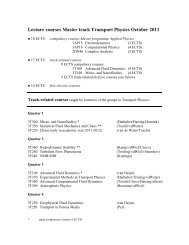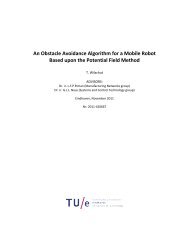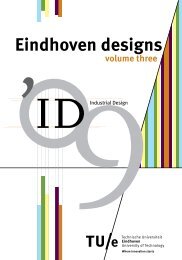Education guide 'Eindhoven designs' - Technische Universiteit ...
Education guide 'Eindhoven designs' - Technische Universiteit ...
Education guide 'Eindhoven designs' - Technische Universiteit ...
You also want an ePaper? Increase the reach of your titles
YUMPU automatically turns print PDFs into web optimized ePapers that Google loves.
Eindhoven designs / volume two<br />
27<br />
Technological mediation<br />
But how does one design for social and<br />
societal transformation? What are the<br />
mechanisms that one can use? Philip<br />
Ross devoted his PhD thesis to social<br />
transformation with an emphasis on the<br />
relation between ethics and aesthetics.<br />
He studied how we can we design an<br />
intelligent system or product that elicits<br />
specific values in aesthetic interaction,<br />
which resulted in the Perspectives on<br />
Be¬haviour in Interaction framework,<br />
and the Interaction Quality framework, in<br />
addition to two intelligent lamp designs<br />
for AEI and Luxger, which can evoke<br />
different values in interaction (Ross,<br />
2008). See chapter eight of his thesis for<br />
an explanation and movies at:<br />
http://www.idemployee.id.tue.nl/<br />
p.r.ross/thesis/<br />
For his work, Philip Ross used the<br />
Technological Mediation framework of<br />
Peter-Paul Verbeek, which builds on the<br />
work of e.g. Don Ihde and Bruno Latour<br />
(Verbeek, 2006). Let us briefly explain<br />
Verbeek’s framework that gives us a<br />
vocabulary to discuss and address social<br />
transformation.<br />
“Technological mediation concerns<br />
the role of technology in human action<br />
(conceived as the ways in which human<br />
beings are present in their world) and<br />
human experience (conceived as the<br />
ways in which their world is present to<br />
them).” (p. 363, Verbeek, 2006).<br />
So, technological mediation has two<br />
perspectives: experience and action/<br />
behaviour, both with their own<br />
mechanisms that we will explain further<br />
on.<br />
Transformation of<br />
experience<br />
Don Idhe sees two relationships for<br />
mediating human experiences and<br />
interpretation of reality.<br />
Firstly, there is the embodied relationship<br />
in which the technological artefact<br />
becomes an extension of the human<br />
body. Heidegger (1927; Coyne &<br />
Snodgrass, 1993) calls this a ‘ready-tohand’<br />
tool that typically withdraws from<br />
the user’s attention. For example, when<br />
looking through a pair of glasses one<br />
perceives the environment and not the<br />
glasses. The opposite of ready-to-hand<br />
is present-at hand, in which the product<br />
itself asks for attention instead of the<br />
things you want to do with the product,<br />
for example when it is malfunctioning.<br />
The second relationship is called the<br />
hermeneutic relationship, in which<br />
a person needs to interpret (the<br />
information presented by) the designed<br />
artefact because it’s a representation<br />
of reality. For example, the thermostat<br />
represents the actual temperature, so

















